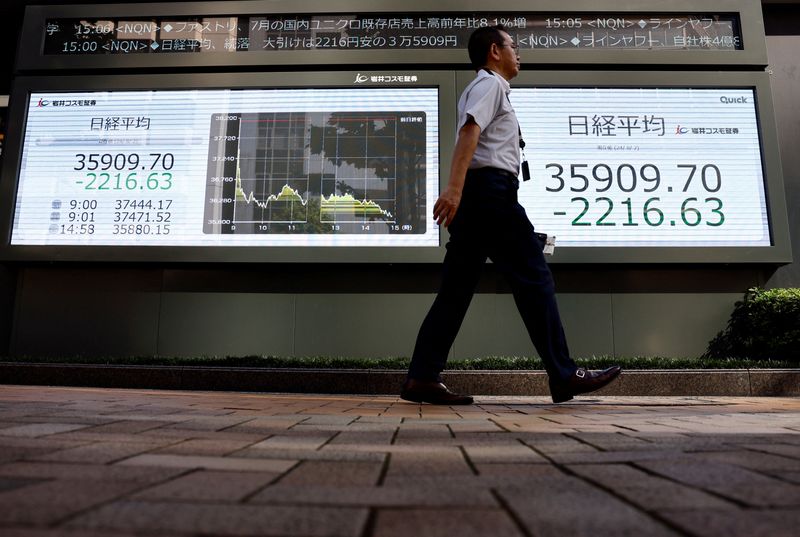By Jamie McGeever
(Reuters) - A look at the day ahead in Asian markets.
Asian markets on Monday get their first chance to react to the extraordinary market moves on Friday that saw stocks and bond yields tumble, and volatility and rate cut expectations soar following an unexpectedly soft U.S. employment report.
That 'risk off' sentiment and momentum is sure to spill over into Asia, which was already wobbling last week after the Bank of Japan's hawkish policy tilt, yet more sluggish Chinese economic data and some weak U.S. tech earnings.
The MSCI Asia ex-Japan stock index slumped 2.5% on Friday, its biggest fall in over two years, and Japan's Nikkei 225 index tanked 5.8% for its biggest fall since March 2020. Japan's broader Topix's 6.1% slide marked its worst day since 2016.
Given Friday's U.S. payrolls-fueled selling on Wall Street, a sharp selloff in Asia early Monday is likely. Friday's market gyrations may prove to be excessive, but they are worth noting.
The two-year U.S. Treasury yield plunged 30 basis points, its steepest one-day fall since the U.S. regional banking shock of March last year. Its weekly fall of 50 bps is in line with those seen in the COVID-19, Lehman, 9/11 and Black Monday crises.
In equities, the VIX volatility index at one point on Friday had doubled from the previous day.
The stampede to unwind carry trades helped push the yen up nearly 5% against the dollar last week - the Japanese currency has only had three better weeks in the past 25 years.
Plunging U.S. bond yields may ease financial conditions - Goldman Sachs's emerging market financial conditions index on Friday fell to its lowest since March - but they're loosening for 'bad' reasons, namely recession fears.
Hopes for the much-vaunted U.S. economic 'soft landing' appear to have completely evaporated, replaced by fears of a 'hard landing'.
Traders are now attaching a 70% chance to the Fed cutting rates by half a percentage point next month, and are pricing in 115 basis points of easing by the end of the year and over 200 bps by next June.
High yield corporate debt markets will be worth watching closely. This is where the first signs of a 'credit event' usually appear, heralding wider retrenchment across businesses, rising unemployment and ultimately recession.
High yield U.S. debt spreads over Treasuries jumped on Friday to the widest of the year of more than 370 bps, but that was mostly due to the slump in government bond yields rather than investors dumping corporate debt. If that dynamic changes, hold onto your hats.
Monday's economic and events calendar in Asia includes service sector purchasing managers index data from across the continent including China, inflation figures from Thailand, GDP numbers from Indonesia and some Japanese earnings.
Here are key developments that could provide more direction to markets on Monday:
- China 'unofficial' services PMI (July)

- Thailand consumer price inflation (July)
- Indonesia GDP (Q2)